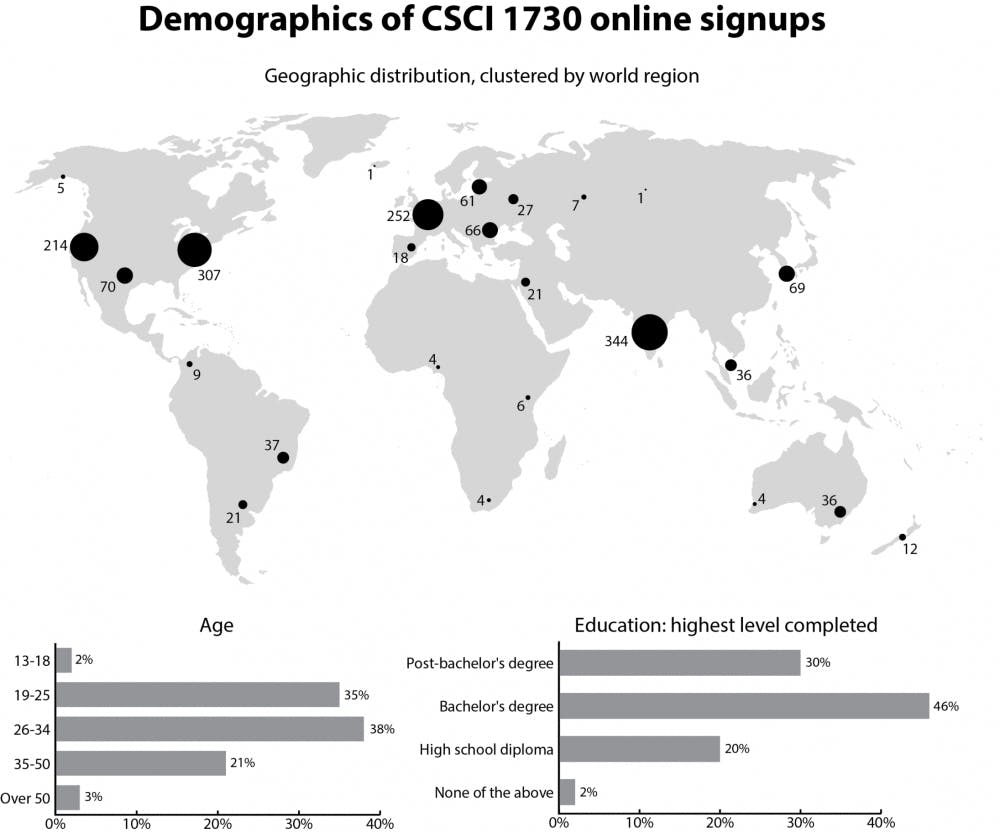Two weeks ago, Dean of the College Katherine Bergeron announced via email that three Brown courses will soon be available online for free worldwide through the Coursera platform. But one computer science professor, Shriram Krishnamurthi, has already begun offering an online version of his course CSCI 1730: "Programming Languages."
Krishnamurthi said his decision to offer the course both in-person and on the web was independent of the University's move toward online education. By the time the University announced its plans to offer online courses, Programming Languages already had 600 sign-ups.
Online attraction
Of the approximately 1,600 participants enrolled in Krishnamurthi's course, most are professional programmers, clustered in the northeastern U.S., California, Western Europe and India. Others are high school students, and some are professors who know the material but are interested to see how Krishnamurthi runs his class.
Krishnamurthi anticipates that about 100 students will complete the course among those initially enrolled. Between 400 and 500 students submitted the course's first quiz.
Krishnamurthi said he intentionally made the first assignments difficult so students would know what they were in for - Programming Languages, he noted, is not an introductory course, and students across the country may not know what is expected in a Brown class.
The professor stressed the importance of keeping up with peers that are forging ahead with online learning.
"You either grow or ossify," Krishnamurthi said. "If we don't do this, we're going to take a serious reputational hit. All the other major universities are doing it - students talk about the schools where other courses are being offered. Being too much of a shrinking violet and too cautious will actually be a bad thing."
Currently, 16 universities are partnered with Coursera, which offers 124 courses in total.
Rather than using a platform like Coursera or Udacity, Krishnamurthi decided to create his course with pieces from multiple sites - using YouTube for posting videos and a tool called Piazza to run an online discussion board. He and his graduate student teaching assistant, Joe Politz, whom Krishnamurthi called the co-instructor of the online course, felt confident they could build any additional software as the course progressed, he said.
Roberto Tamassia, chair of the computer science department, said he likes to impress upon faculty members that "the teaching of an individual can have an impact on thousands of students" beyond their respective universities. Teaching an online course expands one's influence similarly to how writing a textbook does, he said.
"Shriram (Krishnamurthi) is pretty well-known in the programming language community," said Jason Shum '14, a student taking CSCI 1730. "People are taking his class because they want to learn from him specifically."
Online classes can also supplement in-person classes by providing a large amount of data for professors to analyze, Tamassia said. Tracking students' progress in detail may help professors design better lectures and assignments.
A learning experience
Krishnamurthi now films his Brown classes and posts the videos online for anyone to watch. Viewers can see Krishnamurthi respond to questions from Brown students, though the students themselves are out of sight.
One of the major challenges in online learning is grading assignments, especially when course enrollment balloons. But Krishnamurthi said he likes to assess his students via open-ended questions that require essays as answers, and he did not want to water down his course for the sake of easy grading.
He is making all the assignments he gives to Brown students public, but online participants will only receive grades on assignments that can be computed automatically, like scores on a multiple choice quiz. The teaching assistants will run the programs that the online students submit to see if they work, but they will not actually examine the coding behind them, as they will for University students.
All students can ask questions and help each other on Piazza.
Aimee Lucido '13, a student in the classroom version of CSCI 1730, said it is useful to have a joint forum for questions. Because so many students are in the online course, she said, "there are a lot of people who are answering questions. You're more likely to get an answer quickly."
Krishnamurthi spends between three and 10 hours a week monitoring the forum, which he said is the major additional time commitment of the online course.
Though creating an online course required these changes, Krishnamurthi has always made his content available online for free. He said he avoids systems like Blackboard that prevent people from outside the University from accessing his course site.
For Krishnamurthi, the decision to create an online course stemmed from his desire to tackle a new challenge and learn whether he could use the web to improve his teaching, he said.
The Brown advantage
Despite the work he has put in to his online course, Krishnamurthi said he does not think online learning can match in-person classes.
"There's a real value addition to being a Brown student," Krishnamurthi said, citing the ability to ask questions in class, attend TA office hours and receive detailed feedback on open-ended assignments.
Lucido said one of the best parts of the Brown computer science department is the TA program, which the online students cannot access.
Tamassi echoed this sentiment, saying Brown students likely get a much richer experience than those who are enrolled online.
"Are the people in India getting my course? I don't think they are," Krishnamurthi said. "A central part is being there."

ADVERTISEMENT




